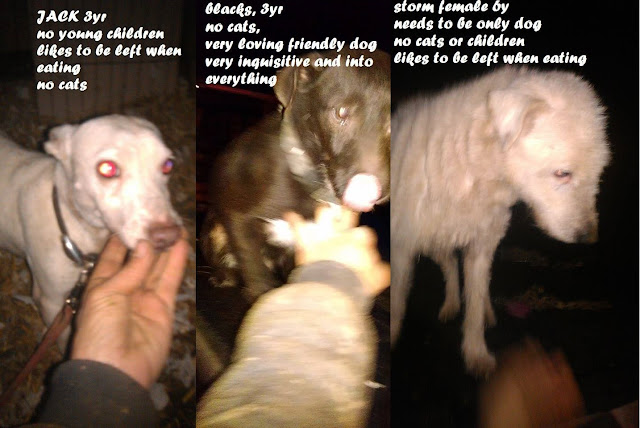ALL OF THESE DOGS ARE ON A FARM IN YORK AND THE LADY NEEDS OUR HELP
she has been inundated with dogs, and with the weather recently I would imagine taking care of these dogs would be a lot harder.
these are dogs that will need to learn how to live in a family home.
FOSTERING??????????
it isn't for everyone
It isn't for the busy family's that have no time to show their foster love, or show them guidance to help prepare them for next home
It isn't for those that think all they need is food, water and a roof over their head
It isn't for those that think its acceptable that the children can do anything to these dogs and for those dogs not to react
We at Broken Halo say anyone can foster a pet as long as :-
we can find the right match
you follow our guidelines
you have the care and compassion in your heart
you can provide love
exercise
a secure routine
and a safe place
we always do our best not to discriminate,
no matter what your ability
it isn't about what you can't do
it is about what we can do for you and what you can do for your foster
WHY DO PEOPLE CHOSE NOT TO FOSTER
The main one we hear time and time again is "it will hurt too much when giving up a pet",
sorry, but it hurts me too much when I read a healthy pet was PTS because we had no foster or no one wanted to foster another staffie
" I am worried I wont be able to give pet up when its time"
we love failed fosters, you want to adopt your foster, tell the rescue
here are some estimated statistics
its is said that out of 10 of Staffordshire bull terriers born.
half of them will be PTS before there first birthday, simply because there is no where for them to go, because owners don't train these high energy dogs.
Another 2or 3 will be PTS before their 4th birthday
only one of the puppies will live long enough to see his/hers 5th birthday, (if they are lucky and not be stuck in kennels)
below 2011 statistics
About the stray dog problem in the UK
The UK has a serious dog overbreeding problem and stray and abandoned dogs are sadly paying the price – with their lives.- Over 125,000 STRAY DOGS are being collected by Local Authorities each year.
- Statistics from the 2011 Dogs Trust survey reveal that 126,176 dogs were picked up in the previous 12 months which equals 345 stray dogs being found every day.
- Some of these stray dogs are reunited with their owners and large numbers end up in animal rescues for rehoming, but sadly over 6% (7,121) of stray dogs were put to sleep by Local Authorities due to lack of homes.
- That’s 20 dogs put to sleep each day in the UK by Local Authorities.
On top of this figure we have to add the dogs euthanised by rescues that don’t have a proper ‘no-kill’ policy. Some rescue organisations will have a dog put to sleep if a home cannot be found within a reasonable time, or if a dog is in need of extra training and care.
The statistics on this vary and are hard to find, but it’s probably safe to assume that at least another 10,000 dogs, probably more, are put to sleep by such organisations each year.
So what’s causing the problem?
There are a lot of contributing factors but the basic facts are:- Too many people are breeding dogs
Even though Council pounds and rescues are overflowing, people continue to breed their dogs, especially the breeds that are currently the worst affected like Staffies and other Bull Breeds - Too many people are abandoning their dogs and allowing them to stray
125,000 + per year, the equivalent of 342 dogs arriving in council pounds every day - Too many people are buying puppies/dogs
instead of adopting a dog from rescue. There are always thousands of dogs looking for new ‘forever homes’.
Could you volunteer to help rescue dogs?
With more volunteers and more donations, animal Rescues can save more lives. Please do what you can to help:
If this was 4 yours ago imagine how much that has risen by now.
it is estimated of the amount of dogs being Put To Sleep each year has increased by 75%







